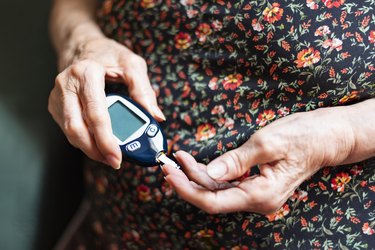
Type 2 diabetes is a condition marked by chronically high levels of sugar in your bloodstream which, if left untreated, can cause devastating complications down the line.
Consider that the SparkNotes definition of a complicated condition that affects more than 30 million Americans, according to the Centers for Disease Control and Prevention (CDC).
Here, we'll dig deeper into what you should know about type 2 diabetes, from the first symptoms to the most common treatments.
So, What Is Type 2 Diabetes?
Type 2 diabetes is a condition that affects how your body processes food, Vandana Sheth, RD, a registered dietitian, certified diabetes educator and author of My Indian Table: Quick & Tasty Vegetarian Recipes, tells LIVESTRONG.com.
The food you eat is broken down into sugar molecules in the bloodstream. If everything is functioning normally, your pancreas releases the hormone insulin, which then attaches to the sugar molecules in the blood and moves them into your cells.
"Insulin functions as the key that unlocks the door that allows sugar to go from the bloodstream into the cells and tissues to be used as fuel," explains John Buse, MD, PhD, chief of endocrinology at UNC Health in North Carolina.
In people who have diabetes, though, the cells don't respond well to insulin, a situation called insulin resistance, according to the National Institute of Diabetes and Digestive and Kidney Diseases (NIDDK). If the pancreas can't produce enough insulin to adjust, the sugar molecules linger in your blood, which can lead to all sorts of problems, from blindness to heart issues.

What's the Difference Between Type 1 and Type 2 Diabetes?
Although both type 1 and type 2 diabetes involve involve too-high levels of sugar in the bloodstream, they have different causes and treatments, according to Harvard Health Publishing. Type 2 is linked to genetics as well as lifestyle factors, such as having overweight or obesity, while type 1 is usually caused by an autoimmune reaction.
"The body just stops making insulin," Sheth says of type 1. "That usually happens pretty rapidly."
People with type 2, on the other hand, still produce some insulin, but their bodies aren't able to use it properly.
Type 2 is more common by far: According to the CDC, about 90 to 95 percent of people with diabetes in the U.S. have this type.
Type 1 is more often (though not exclusively) diagnosed in children, teens or young adults, whereas type 2 is more often diagnosed in adults, with about one-third of people over the age of 65 having the condition, Dr. Buse says.
In terms of treatment, people with type 1 diabetes have to take insulin every day, otherwise they'll die. Those with type 2 may be able to manage their condition through lifestyle changes (more on that below) but may eventually need insulin if they're unable to keep their blood sugar levels well controlled.
Causes of Type 2 Diabetes
The immediate cause of type 2 diabetes is not having enough insulin to usher sugar out of the bloodstream. What causes insulin resistance is still a bit of a mystery, says Dr. Buse, but it seems to involve a combination of factors.
1. Genetics
Your genes are one part of the equation. Type 2 diabetes tends to run in families and is also more common in certain racial and ethnic groups, such as African-Americans, Hispanics and Latinos, Native Americans and Pacific Islander, notes the NIDDK.
If you have a parent or sibling with type 2 diabetes, your risk is also higher, Sheth says.
2. Having Overweight or Obesity
"Overweight or obesity is very tightly linked to insulin resistance," Dr. Buse says. "If you have a genetic predisposition to not being able to make enough insulin and then you [have] overweight or [obesity], it can cause diabetes to manifest itself."
Do Have Overweight?
Plug your info into LIVESTRONG.com's BMI calculator to determine if your weight is in the healthy range.
This is especially true if the fat is concentrated around your belly, according to the NIDDK.
3. Age
Your risk of developing the condition increases markedly after age 45, according to the CDC, although more and more children, teens and young adults are being diagnosed.
4. Exercise Habits
People who are physically active less than three times a week are at a higher risk for type 2 diabetes, according to the CDC.
5. Medical History
Women who had gestational diabetes during pregnancy or have ever given birth to a baby that weighed more than 9 pounds are more likely to develop type 2, per the CDC.
6. Other Risk Factors
Less common causes of type 2 diabetes include some hormonal disorders like Cushing's syndrome and hyperthyroidism, damage to your pancreas (including surgery to remove part of it) and certain medications, including niacin (vitamin B3) and steroids, according to the NIDDK.
Statins to lower cholesterol may also contribute, but generally the benefits (lowering the risk of heart disease and stroke) outweigh the risk.

Symptoms of Type 2 Diabetes
More often than not, type 2 diabetes doesn't have any symptoms in the early phases of the disease, according to the American Diabetes Association (ADA). And when there are symptoms, they're typically so mild you may not even notice them.
Those symptoms might include:
- Needing to urinate frequently
- Feeling very thirsty and hungry, even though you're drinking and eating
Many people never know they have diabetes until they develop symptoms of diabetes complications such as numbness in their feet, high blood pressure, blurry vision and skin infections, according to the ADA.
Related Reading
Diagnosing Type 2 Diabetes
Given that there are typically no early signs of type 2 diabetes, the only way to know for sure if you have the condition is to get a formal diagnosis, Dr. Buse says.
That's why it's so important to get screened, especially if you have risk factors. More than 20 percent of the 34 million people with diabetes go undiagnosed, per the ADA.
ADA guidelines recommend that everyone over the age of 45 get screened, as well as people who have risk factors like having a high BMI.
There are three main tests to diagnose diabetes, Dr. Buse says.
1. Fasting plasma glucose (FPG) test: This test measures your blood sugar levels after you've been fasting and drinking only water for eight hours (usually overnight), according to the ADA.
It's low-cost and easily accessible, but results can be skewed if you're stressed or sick, per the NIDDK. It also only measures your sugar levels at one point in time.
The ADA considers fasting plasma glucose levels of less than 100 mg/dl to be normal, while 100 mg/dl to 125 mg/dl indicates prediabetes and levels of 126 mg/dl or higher mean you have diabetes.
2. A1C test: "This looks at the person's average blood sugar over a period of two to three months," Dr. Buse explains. "It's a report card of how well you're doing."
While this is a better measure of your longer-term blood sugar levels, it's expensive and may miss some cases, per the NIDDK.
The ADA says numbers less than 5.7 percent are normal, while prediabetes is 5.7 to 6.4 percent and diabetes is 6.5 percent or higher.
3. Oral glucose tolerance test (OGTT): This test is complicated to do and is usually reserved for pregnant women, Dr. Buse says. It involves testing your blood sugar two hours before and two hours after you drink a sugar-laden beverage, according to the ADA.
It may not be convenient but it is accurate, per the NIDDK. According to the ADA, a normal level is less than 140 mg/dl while prediabetes is 140 mg/dl to 199 mg/dl and diabetes is 200 mg/dl or higher.

Treating Type 2 Diabetes
Type 2 diabetes treatment usually starts with lifestyle changes (think: diet and exercise), then moves on to medication and possibly insulin.
"Type 2 diabetes is a progressive condition, so it's important to know your care and treatment plan will evolve," Sheth says. "It's not that you're a failure or what you did was wrong. It just means you need more support."
Lifestyle Measures
For diabetes in its earlier stages, lifestyle measures including diet, physical activity and stress management may be enough to keep blood sugar levels under control.
Experts are mixed on whether you can actually "cure" or "reverse" diabetes but, says Sheth, "you can absolutely manage your blood sugar."
Food preferences are very individual and there's no one diabetes diet, Sheth says. Most guidelines, however, suggest people with diabetes focus on the following foods:
- Fruits
- Non-starchy vegetables (broccoli, carrots, leafy greens)
- Whole grains (wheat, rice, oats, cornmeal, barley, quinoa)
- Lean poultry
- Fish,
- Eggs
- Legumes
- Low- or non-fat dairy
- Monounsaturated oils (olive, canola, sesame)
It may help to work with a nutritionist.
Regular physical activity is key, too. Aim for at least 150 minutes a week of moderate-intensity physical activity, like walking or bicycling, per the CDC.
Finally, make sure you manage stress, which can cause blood sugar levels to skyrocket and lead to poorer dietary choices (hello, emotional eating).
Having support is key to all of these measures. The National Diabetes Prevention Program has made a big difference for some people. "It's not just education but a support system, checking in every week or every other week with a group of peers," Sheth says.
Medications
Medications step in when lifestyle measures are no longer enough to control blood sugar levels. They work in different ways, from helping your tissues respond better to insulin, increasing how much insulin your pancreas produces, slowing down your digestion and more, according to Harvard Health Publishing.
Medication management usually starts with metformin (Glucophage), Dr. Buse says. According to the ADA, metformin lowers the amount of glucose your liver produces and also makes tissue more sensitive to insulin.
After that, your doctor may prescribe other oral medications that help lower blood sugar, such as DPP-4 inhibitors like sitagliptin (Januvia) or SGLT2-inhibitors like empagliflozin (Jardiance).
Even with medication, people with type 2 diabetes still need to keep up with the lifestyle measures mentioned above, Dr. Buse says.
Insulin
About one-third of people with type 2 diabetes will end up having to take some type of insulin injection in order to help usher glucose out of the bloodstream and into cells, according to Harvard Health Publishing.
"Generally we reserve the use of insulin for later on because of the risk of hypoglycemia [low blood sugar]," Dr. Buse says.
As with diabetes medications, there are many different types of insulin. Work with your doctor to discover which is best for you.
Bariatric Surgery
A less common treatment for type 2 diabetes includes weight-loss (bariatric) surgery. Losing weight returns blood sugar levels to normal, and some people with diabetes who've had this surgery can go off medications, according to the NIDDK.
"If done early in the course of the disease, bariatric surgery can put off elevations in blood sugar for a long time," Dr. Buse says.
Related Reading
Complications of Type 2 Diabetes
If blood sugar levels don't stay controlled over time, damage from type 2 diabetes can extend throughout the body. And unless you've been tested, symptoms of these complications are sometimes the first indication of diabetes. Unfortunately, once the damage is done, it can't be reversed.
1. Cardiovascular Issues
People with diabetes are at higher risk for cardiovascular disease, meaning heart attack, stroke or heart failure, Dr. Buse says.
Diabetes can cause atherosclerosis, or fat build-up in the arteries, which can narrow the vessels, according to Harvard Health Publishing. And about two-thirds of people with the condition have high blood pressure, according to Johns Hopkins University.
"In addition to lifestyle therapy and treating blood sugar, we recommend very careful attention to cardiovascular risk factors," Dr. Buse says.
Related Reading
2. Blindness
Diabetes is the leading cause of blindness, Dr. Buse says. This starts with retinopathy, when chronically high blood sugar damages the small blood vessels in the retina and blocks blood flow. Regular dilated eye exams can detect retinopathy in its early stages, according to the National Library of Medicine (NLM).
3. Kidney Conditions
Diabetes is also the main factor driving chronic kidney disease, Dr. Buse says. Those elevated blood sugar levels erode the capillaries in the kidneys, which help filter waste. Eventually, this can result in chronic kidney disease and even dialysis or an organ transplant, Dr. Buse says.
Blood and urine tests can help determine if you have any kidney damage, according to the NLM.
4. Nerve Damage
Feet can be a particular source of trouble in people with uncontrolled diabetes who develop neuropathy or nerve damage.
"This can cause all kinds of symptoms — burning or stinging in the feet, numbness, feet feeling cold all the time," Dr. Buse says. "It can also lead to trouble with urination and digestion as well as erectile dysfunction."
People with diabetes should conduct daily foot exams, as the numbness from neuropathy sometimes means you hurt your foot and don't know it.
5. Skin Conditions
People with uncontrolled diabetes can experience a host of skin issues, from severe itching to bacterial infections, according to the ADA. In fact, these problems are sometimes the first sign that a person has diabetes.
Is this an emergency? If you are experiencing serious medical symptoms, please see the National Library of Medicine’s list of signs you need emergency medical attention or call 911.